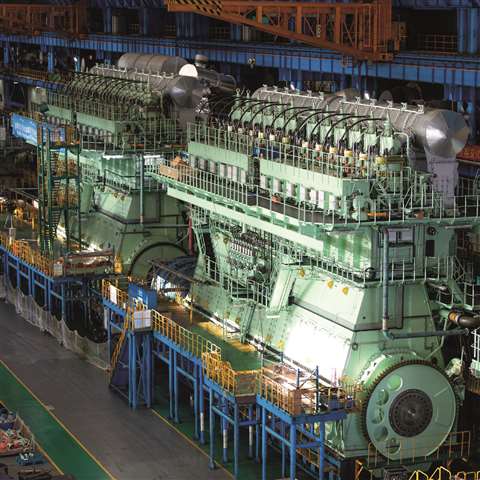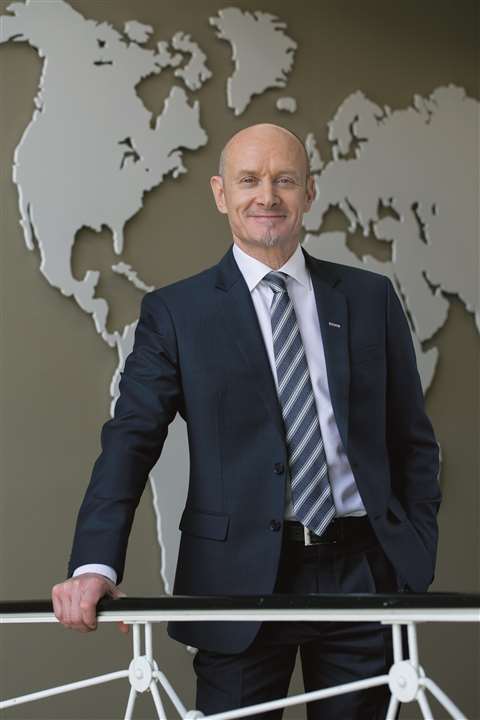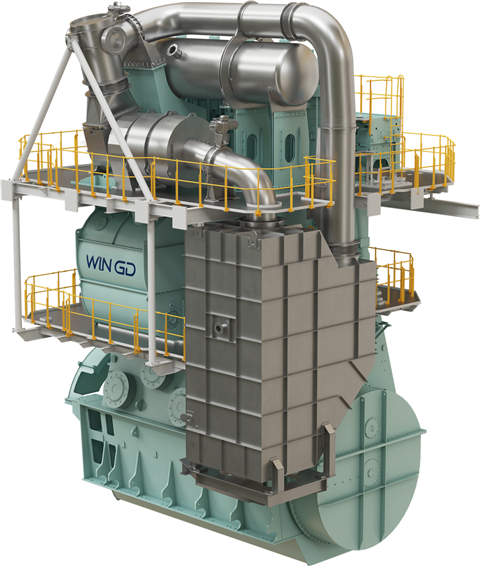WinGD looks to future fuels for ocean-going ships
20 November 2022
 A longtime specialist in two-stroke engine technology, in 2019, WinGD developed the 12X92DF, the largest Otto-cycle engine ever built. (Photo: WinGD)
A longtime specialist in two-stroke engine technology, in 2019, WinGD developed the 12X92DF, the largest Otto-cycle engine ever built. (Photo: WinGD)
There are few large engine manufacturers that have a heritage that goes back as far as WinGD. With its roots dating to 1893 when the Sulzer Brothers signed an agreement with Rudolf Diesel for his then-new engine technology, the company has gone through several iterations until 2015, when Wärtsilä Switzerland Ltd. – at that time responsible for low-speed, two-stroke engines within Wärtsilä – was merged with China State Shipbuilding Corp (CSSC) and renamed Winterthur Gas & Diesel Ltd. (WinGD). A year later, CSSC acquired the remaining shares and the brand became WinGD.
Through all that time and changes, the constant has been the company’s development of large two-stroke engine technology for marine applications.
Diesel & Gas Turbine Worldwide met with Klaus Heim, CEO of WinGD, at the SMM show 2022 in Hamburg, one of the most important exhibitions for the maritime industry.
“Fuels were the topic at this exhibition, something we would not have imagined four years ago when most talks were about emissions and efficiency,” Heim said. “Meanwhile, there is a common understanding on future fuels and that, at least for sea-going vessels, the preferred ones are methanol and ammonia.”
 “No shipping company will take the risk of ordering an engine in 2024 that is fueled by pure methanol because of the uncertainty related to fuel supply.” - Klaus Heim, WinGD CEO
“No shipping company will take the risk of ordering an engine in 2024 that is fueled by pure methanol because of the uncertainty related to fuel supply.” - Klaus Heim, WinGD CEO
According to Heim, hydrogen has been taken into consideration, but the transport onboard poses a few issues, especially for ocean-going vessels. “Transporting hydrogen onboard is first of all very expensive – the tank alone for such small molecules needs a very advanced and costly building technology – without mentioning that hydrogen needs to be cooled down and maintained to a temperature of -253 °C,” he said. “Furthermore, the space needed for storing hydrogen is much bigger than that needed with ammonia or methanol.”
Heim added that hydrogen is still an available solution for vessels used on coastal routes or on inland waterways.
Another key issue to consider is the availability of new fuels; making sure green fuels will be available globally and in the necessary quantities is a major challenge. “I talked recently to a senior executive in the oil industry and asked when their industry will be able to supply future fuels in the quantity necessary for global marine shipping,” said Heim. “The answer was that the best estimate, assuming the right political pressure and regulations adopted globally, is a 10-year period. More realistic, it is probably a 20-year span.”
A roadmap for green fuels
Considering these assumptions, WinGD developed its own roadmap to meet the challenges and requirements of the maritime industry in terms of green fuels. The first WinGD two-stroke dual-fuel engine fueled by e-methanol will be available in 2024 and it will likely be one of the smaller sizes in the company’s range, either the 520 mm or 620 mm bore engines.
“There is actually such a strong demand from customers that we are reviewing our roadmap to accelerate the roll-out of the first methanol-ready engine and to follow with the other bore sizes, as well,” Heim said.
An ammonia-ready dual-fuel engine is expected to follow in 2025 and again it will likely be one of the smaller sizes. But Heim said there is a thriving demand for ammonia adoption on the whole range, which will likely drive a timeframe acceleration for ammonia technology, as well.
 WinGD has developed its own roadmap to meet the challenges and requirements of the maritime industry concerning green fuels. (Photo: WinGD)
WinGD has developed its own roadmap to meet the challenges and requirements of the maritime industry concerning green fuels. (Photo: WinGD)
Considering that a shortage of future green fuels has to be expected for a certain period of time, Heim believes the industry would probably have to deal with blended fuels. “For example,” he said, “mixing methanol with a percentage of diesel could be an intermediate solution towards a zero-emissions future that would cope with fuel shortages.”
Heim reported that customers already have concerns about fuel availability, which is the main reason dual-fuel engines are quite popular. “No shipping company will take the risk of ordering an engine in 2024 that is fueled by pure methanol because of the uncertainty related to fuel supply,” he said. “Dual-fuel engines give the option to switch back to operating on diesel or low-sulfur heavy fuel oil if needed and to give customers the confidence to operate with future fuels.”
 One of WinGD’s recent innovations for dual-fuel engines is the Intelligent Control by Exhaust Recycling (iCER) system designed to reduce methane slip during LNG combustion, especially in low-pressure Otto-cycle engines. (Photo: WinGD)
One of WinGD’s recent innovations for dual-fuel engines is the Intelligent Control by Exhaust Recycling (iCER) system designed to reduce methane slip during LNG combustion, especially in low-pressure Otto-cycle engines. (Photo: WinGD)
Ready conversion required
From a technology perspective, turning a traditional dual-fuel engine into a methanol- or ammonia-fueled unit is mostly a matter of changing or adjusting certain systems. Heim said the engine’s mechanical parts remain the same but fuel-related systems such as fuel injection and combustion need to be adapted. “We are running evaluations to determine the characteristics of methanol combustion,” Heim said. “It is not more difficult than with diesel, just different so we need to explore the boundaries to make sure we understand them.
“When a ship powered by LNG is converted to methanol or ammonia, it is not only the engine that needs changing – the entire fuel system onboard needs to be adapted while taking care of health and safety requirements. In terms of safety, new fuels are more complicated, especially ammonia, which is highly toxic. Any possible ammonia leakage on board must be avoided, which means adopting measures like a double-walled fuel system, sensors to detect leakages and safety systems to handle any leakage however small.”
Heim said that a shipyard that adopts a WinGD dual-fuel engine today is guaranteed that it can convert it to future fuels at some point in time. “It is actually what customers are asking for,” he said. “Almost all new projects our customers are discussing today involve the question if the engines are ready for future fuels.”
Further developments
For ships that can refuel frequently, hydrogen remains an option as well as battery-electric hybrid solutions. “WinGD is offering hybrid solutions that include an engine running on conventional fuels combined with a battery and a generator that is coupled to the main shaft,” Heim said. “It is a system where energy flow can be optimized according to demand.”
For hybrids, WinGD offers system engineering and its proprietary energy management system to manage and optimize energy flow.
WinGD is also carrying out developments on its traditional dual-fuel engines. One of the most recent introductions is the new Intelligent Control by Exhaust Recycling (iCER). Heim explained that the iCER is designed to reduce the methane slip during LNG combustion, especially in low-pressure Otto-cycle engines, and increase efficiency. The system incorporates “double combustion,” with the captured methane in the exhaust gas brought back to the combustion chamber.
Finally, WinGD is also introducing upgrades in its digital offering WiDE (the company’s Integrated Digital Expert), which is a comprehensive performance monitoring system that uses data analytics and algorithms to help the customer to further optimize engines while also detecting possible problems in real time. The company has set up remote monitoring centers in Switzerland and in South Korea that watch over engines in operation 24/7.
WinGD and Korean engine builder HSD Engine have initiated a joint development project to advance the development of WinGD’s methanol-fueled big-bore engines. The aim is to deliver an engine capable of running on carbon-neutral green methanol by 2024.
Under the agreement, WinGD will oversee combustion and injection research, exhaust aftertreatment requirements and engine concept design. HSD Engine will provide support on cost-effective manufacturing and assembly, provide engine testing capabilities and deliver fuel supply and exhaust aftertreatment systems.
The project will focus on some of the largest engines in the WinGD portfolio, the X92 and X82.
WinGD and Hyundai Heavy Industries’ Engine Machinery Division announced a collaboration on delivering the first WinGD engine capable of running on ammonia. The project will explore ammonia concepts for both diesel-fueled WinGD X-type engines and dual-fuel LNG X-DF engines and the two parties will aim to deliver a first engine by 2025.
STAY CONNECTED




Receive the information you need when you need it through our world-leading magazines, newsletters and daily briefings.
POWER SOURCING GUIDE
The trusted reference and buyer’s guide for 83 years
The original “desktop search engine,” guiding nearly 10,000 users in more than 90 countries it is the primary reference for specifications and details on all the components that go into engine systems.
Visit Now
CONNECT WITH THE TEAM









